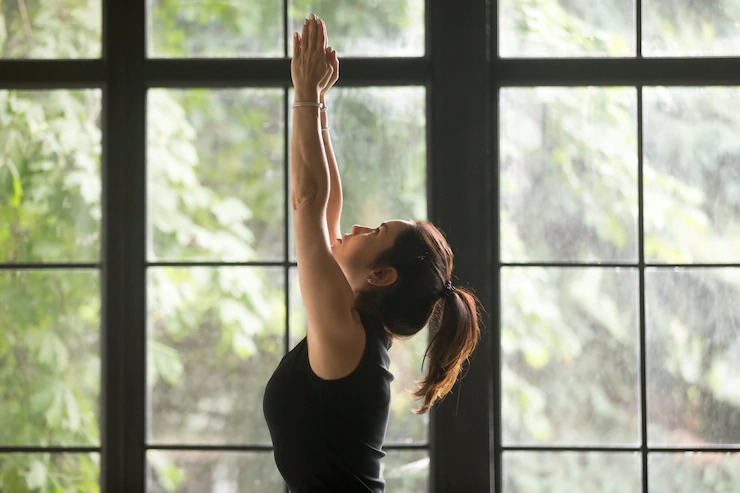What is Tadasana Yoga Pose?
Yoga is much more than a combination of stretching exercises that give you a toned body and strong muscles. This 5000-year-old philosophy and science aims to create a balance and harmony between the practitioner’s body and mind through mindfulness, meditation, and breath control exercises.
Besides these, yoga is a combination of different asanas or physical postures. Developed thousands of years ago in India, these asanas are a part of hatha yoga that help you achieve spiritual, emotional, and physical benefits.
These yoga asanas are categorised depending on physical orientation i.e. the placement of the head vis-à-vis the body. Depending on this, these include standing, inverted, sitting, twisting, balancing, and reclining asanas.
Out of all these, standing yoga poses are considered to be the foundational blocks of yoga practice. They are essential for not just improving your fitness, but also for impacting your immunity and mental strength.
The asana that lays the foundation of all standing asanas is Tadasana where tada means mountain and asana means seat or posture. It is also known as ‘Samasthiti’ in Sanskrit and ‘Mountain Pose’ in English, both translating to a balanced and stable pose.
Tadasana yoga pose makes for a great starting as well as resting posture. For instance, it is with this yoga mountain pose that the Surya Namaskar (Sun Salutation) sequence begins and ends.

Who Can do the Tadasana Yoga Pose?
This yoga mountain pose is simple and easy to learn and practice. With a few modifications, it can be done by anyone irrespective of their age, general health, and fitness level such as:
- Seniors or those with limited flexibility can easily do the Tadasana yoga pose.
- Children as young as 7 years can do this pose.
- Pregnant women can do this pose.
- It is an ideal pose for beginners.
- People who have a limited range of motion.
- Those who have suffered an injury and are recovering can do the Tadasana yoga pose.
- Anyone who has undergone surgery and is healing.
- People who have balance and coordination problems.
Who Should Avoid the Tadasana Yoga Pose?
There are some categories of people who should avoid doing the Tadasana yoga pose. These include:
- People who cannot stand for long periods. This could be due to an injury, surgery wound, or a limited range of motion.
- People who suffer from vertigo, nausea, or giddiness should avoid the Tadasana yoga pose.
- Those who have frequent headaches or migraine attacks.
- People who have spinal problems.
- Those who suffer from low blood pressure.
- Beginners who are yet to learn the technique of Tadasana yoga asana technique correctly.
How to Do the Tadasana Yoga Pose?
To gain its benefits, it is important to know the correct Tadasana procedure. Here are the steps of Tadasana for you to perfect its form:
- Stand straight while keeping your feet hip-width apart.
- Your arms should be straight and placed beside your body.
- Engage your thigh muscles and raise your kneecaps slowly. Remember not to contract your abdominal muscles.
- Gently rotate your thighs inwards and raise your pelvis towards the navel while drawing your belly in slightly.
- Raise your shoulders towards your ears and then roll them back towards your back.
- The crown of your head should extend towards the sky along with your sternum.
- Hold this pose for seven to ten breaths and come back to the starting position.
Pertaining to the duration of Tadasana yoga asana, if you are a beginner, you can do this Tadasana procedure for ten to twelve seconds about two to three times a day. People with advanced practice can hold the pose for as long as they can and repeat the pose even ten times in a day.
Which Are Some Variations of Tadasana?
There are hundreds of variations of yoga poses for Tadasana. Here are some of the most common variations that start with assuming the basic position of Tadasana yoga as mentioned above:
1.Tadasana Paschima Namaskar
This variation of yoga pose for Tadasana, also known as the Reverse Prayer Pose, is a natural progression of the traditional pose and involves a Namaskar pose, done at the centre of your back. This particular Tadasana yoga pose gives your chest and shoulder muscles a stretch and is believed to open the heart chakra. This pose also helps calm your mind by reducing stress and anxiety.
2. Tadasana Urdhva Hastasana
The term Tadasana Urdhva Hastasana translates to upward hand stretch mountain pose. This is a full-body stretch that requires you to raise your arms above your head. Your palms are either kept pressed together or apart while you gaze ahead or towards the direction of your hands.
This pose of Tadasana benefits people who suffer from postural problems. It helps in improving your circulation and relaxing tight neck and shoulder muscles. It also helps in keeping your digestive system healthy and tones your thigh muscles.
3. Baddha Hasta Tadasana
Translating to ‘Bound Hands Mountain Pose’, in this variation, you need to raise your arms towards the ceiling. While doing so ensure that your shoulders are not hunched.
This variation improves your posture by giving your core, neck, and shoulder muscles a good stretch. This is also helpful in increasing the capacity of your lungs and relieving stress and anxiety.
What Are the Benefits of Tadasana?
Now that you know how to do Tadasana, here’s a roundup of some of the most important benefits of this asana. Though the asana may seem like a simple one, the benefits of Tadasana help you lead a healthy life in more ways than one.
Here are some great reasons to include this asana in your daily routine:
- By activating, stretching, and strengthening the muscles in your core, shoulders, arms, and neck, it helps improve your posture. Not just this, the pose also reduces posture-related pains and stiffness.
- Tadasana yoga asana tones your abdomen and hips and improves metabolism. By reducing the accumulation of fat in these regions, it prevents several chronic obesity-related diseases such as diabetes, heart problems and hypertension.
- One of the most important benefits of Tadasana is that it enhances your balance and coordination and prevents injuries from falls. This is especially important for seniors or those who have a limited range of motion.
- Another important Tadasana yoga benefit is that it improves your circulation. Better circulation improves your immunity and keeps your organs functioning optimally.
- One of the most important circulation-related Tadasana yoga benefits is that it improves your cognitive functioning and enhances your focus, memory, and concentration. This is also important for preventing neurodegenerative conditions such as Alzheimer and Parkinson’s.
- One of the best Tadasana benefits is for people who have respiratory issues. By strengthening your lung muscles, it not just prevents conditions such as COPD and asthma but also reduces their discomforting symptoms.
- The steps of Tadasana make your lower body muscles such as quadriceps, calves, and hamstrings stronger. This helps in improving your functional ability and quality of life.
What Are Some Tips for Doing Tadasana Safely?
Just knowing the Tadasana steps and benefits is not enough to gain its benefits. There are some things that you need to keep in mind to do Tadasana yoga pose safely:
- Never start doing this asana on your own. It is essential to learn the Tadasana steps and benefits from a qualified yoga practitioner. This helps in preventing injuries and stress.
- The right time for Tadasana is in the early morning hours. This is when you are not rushing between things and your bowels are empty.
- Never hurry while doing Tadasana yoga asana, especially if you are a beginner. Start slow and build your practice.
- Don’t do this asana if you are suffering from fever or cold.
- This asana must be avoided if you are experiencing extreme stress or anxiety.
Conclusion
Tadasana is an amazing asana that helps you become stronger and enjoy life to the fullest. However, Tadasana benefits can only be attained if you are consistent in your practice. It is also important to keep challenging yourself by trying Tadasana variations for optimising your health.
Commonly Asked Questions for Mountain Pose (Tadasana)
What are the benefits of Mountain Pose(Tadasana) for body and mind?
The benefits of Mountain Pose(Tadasana) extend beyond physical alignment. As detailed by Harvard Health Publishing, it strengthens the thighs, knees, and ankles while improving posture. On a mental level, Tadasana fosters a sense of groundedness and balance. FlexifyMe highlights its role in improving focus and calmness, making it ideal for both body and mind rejuvenation. Regular practice can also help in stress reduction and increased awareness.
Is Mountain Pose(Tadasana) a good beginner yoga pose and how can I modify it?
Mountain Pose(Tadasana) is an excellent beginner yoga pose due to its simplicity and the foundation it provides for balance and alignment. Beginners can modify it by placing feet hip-width apart if balancing is difficult, as suggested by Yoga Basics. FlexifyMe advises beginners to focus on the sensation of the earth beneath their feet and the upright spine, enhancing mindfulness and body awareness.
What are common mistakes to avoid and tips for improving alignment in Mountain Pose(Tadasana)?
Common mistakes in Mountain Pose(Tadasana) include uneven weight distribution and slouching. Yoga International recommends evenly spreading your weight across both feet and engaging your core for proper alignment. FlexifyMe suggests regularly checking in with your body alignment during the pose, ensuring your shoulders are relaxed and your neck is long. These adjustments not only improve the pose but also enhance the overall benefits.
Why is Mountain Pose(Tadasana) important in yoga and how does it benefit other poses?
Mountain Pose(Tadasana) is crucial in yoga as it establishes the principles of alignment and balance. As per Yoga Journal, it is the foundation from which other standing poses evolve. FlexifyMe explains that mastering Tadasana improves posture and stability in more complex asanas, making it a cornerstone for yoga practice. Its benefits in improving posture and body awareness are essential for progressing in yoga.
Can I practice Mountain Pose(Tadasana) outside of yoga class and how often should I do it?
Absolutely! Mountain Pose(Tadasana) can be practiced anywhere, anytime. It's a simple yet powerful pose that can be integrated into daily routines. As suggested by FlexifyMe, practicing it for a few minutes daily can help maintain good posture and reduce tension. There's no set rule on frequency, but incorporating it regularly into your day can yield significant benefits.
What are questions and considerations regarding practicing Mountain Pose(Tadasana)?
When practicing Mountain Pose(Tadasana), consider your body's limitations and comfort. Questions to ask include: Am I distributing my weight evenly? Are my shoulders relaxed? FlexifyMe emphasizes listening to your body and adjusting the pose as needed, ensuring it feels right for you.
Are there risks or alternative poses for those who cannot do Mountain Pose(Tadasana)?
While Mountain Pose(Tadasana) is generally safe, those with balance issues or foot problems should take caution. Alternative poses include seated or chair variations, providing similar alignment benefits. FlexifyMe advises consulting with a yoga instructor or healthcare provider if you have specific concerns or health conditions.


